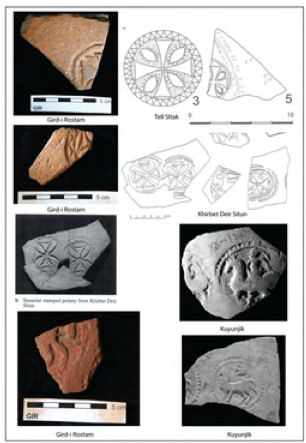From the Field: The First Excavation Season at Gird-i Rostam, Kurdistan
This June/July, Professor Daniel T Potts directed the first season of excavation in the largely unexplored, far eastern part of the Sulaimaniyah Governate, Kurdistan at the site of Gird-i Rostam. The project is a collaboration between the Sulaimaniyah Directorate of Antiquities, the Ludwig-Maximilians-University (Munich) and ISAW.
The team opened a step trench and two deep soundings. Three large, superimposed stone structures, as well as a thick deposit of Late Chalcolithic 1-2 material (c. 4800-3800 BC), were exposed in two deep trenches. One of the most important finds was a small inscribed potsherd with an incomplete inscription in Neo-Assyrian ductus which identifies it as a wine jar dedicated to the weather god. It is not clear whether the fill in which it was found dates to the Iron Age or to the Sasanian period, but the other sherds found in the fill point to a Sasanian date. A preliminary reading of the inscription, based on photographs, was made by Prof. Karen Radner (Ludwig).
 In his preliminary report, Professor Potts focused on the Sasanian stamped pottery sherds, many of which show impressed crosses in a circular area, as if made using a wooden die. Stamped pottery is rare in the area, but other examples have been uncovered at Aqar Babira, Birs Nimrud, Nineveh, and Khirbet Deir Situn in Mesopotamia. The presence of the cross is a reflection of the fact that eastern Kurdistan, which was part of Beth Garmai in Late Antiquity, had a large Christian population.
In his preliminary report, Professor Potts focused on the Sasanian stamped pottery sherds, many of which show impressed crosses in a circular area, as if made using a wooden die. Stamped pottery is rare in the area, but other examples have been uncovered at Aqar Babira, Birs Nimrud, Nineveh, and Khirbet Deir Situn in Mesopotamia. The presence of the cross is a reflection of the fact that eastern Kurdistan, which was part of Beth Garmai in Late Antiquity, had a large Christian population.
Die-stamped Sasanian pottery from Gird-i Rostam and comparanda.
The team, which included Kurdish colleagues Amanj Ameen, Parween Yawar and Hero Salih from the Sulaimaniyah Directorate of Antiquities, as well as French, German and Italian members from Paris, Berlin and Munich, is confident that the first season of excavations at Gird-i Rostam has unquestionably demonstrated the great potential of the site. Potts writes: "An enormous quantity of diagnostic pottery was recovered from several relatively small soundings, suggesting that the site was occupied in the Sasanian and Late Chalcolithic periods. An inscribed sherd, a short Neo-Assyrian label attests to Iron Age occupation and, more specifically, a link to the Assyrian empire. The Penjwin region has yet to be intensively explored by archaeologists, but the Gird-i Rostam excavations give every indication that this area of Kurdistan, like the better-known areas to the north and west where multiple excavations are currently ongoing, deserves the attention of all archaeologists interested in the development of Kurdistan through time. Gird-i Rostam affords us an outstanding opportunity to explore both local, indigenous development and the external relations of an area at the crossroads of the Mesopotamian and Zagrosian worlds. We look forward eagerly to the second season of excavations next year."
If you're interested in further reading, Prof Potts recently published an article shedding light on modern day Iran-American relations since 1834.